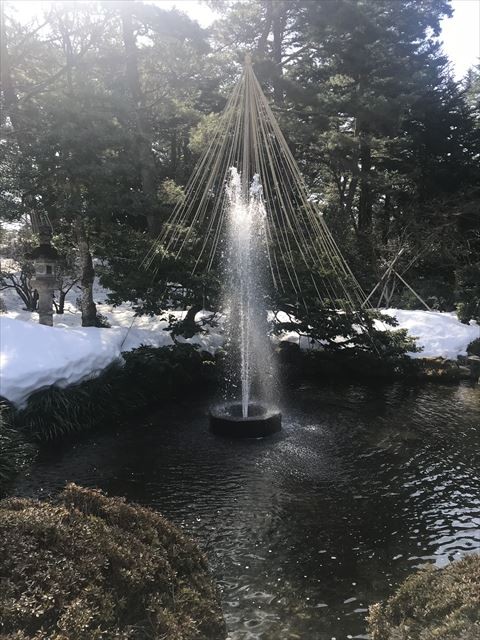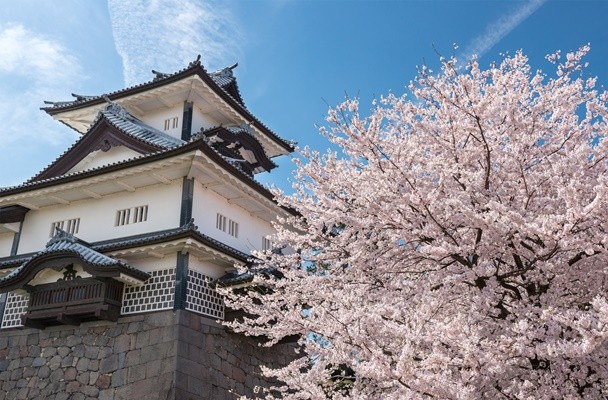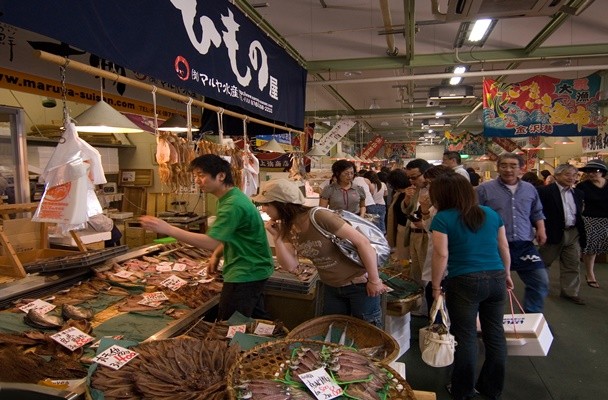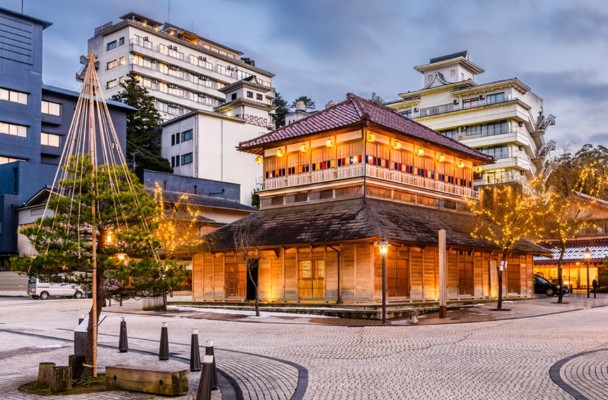目次
- Kanazawa is a nice city
- Yukitsuri, a Japanese technique for preserving trees from heavy snow can be seen at Kanazawa
- The Kanazawa Castle
- Kenroku-en, one of the Three Great Gardens of Japan
- Kanazawa Kaiten Sushi Kirari, best location best price.
- Japan domestic flight, fullfills every needs
- Tokyo nightlife as orange as the Tokyo Tower light that night
Kanazawa is a nice city
I said earlier that Kanazawa had a lot of local cultures, like the living heritage Nodokuro fish, ceramic wares, samurai villas, and the iconic Tsuzumu Gate at Kanazawa Station. The city was actually quite unique, as you could find water sprinklers built in the roads throughout the city, since it had quite a snowfall, so that the water from the sprinklers would help melt the snow. The prefecture museum was quite an attraction too, we went there and found out hundreds of people queuing in line for the admission ticket, meaning that people here be it locals or not actually appreciate art. Never had I ever went to a crowded museum like this before. I found the city to be calm but not empty, busy sometimes but not noisy. I really liked my stay here.
Yukitsuri, a Japanese technique for preserving trees from heavy snow can be seen at Kanazawa
One more thing, I said before about the snowfall here, it had become like an icon to Kanazawa, that you could see everywhere they were using wooden pillar to support the tree branches, all across the city. Then they also put one tall pillar in the middle of the tree, and tie some ropes to the branches, so that the branches would not break by the heavy snow. This made the city more unique and different. They also decorated the manholes across the town; some were colored, with varieties of the pattern on them. One manhole wouldn’t be the same as others.
The Kanazawa Castle
But then we went to the castle, Kanazawa Castle. Yeah, castle defined power. There were castles everywhere throughout every prefecture or province in Japan. Imagine the power that controlled Japan back then, from the Maeda in each province, till the shogun in Edo. Why the Japanese kept every castle in top notch condition until now? Because they appreciate their history so those future generations understand that they had moved on from war, the war wouldn’t solve everything. Power wasn’t something worth to fight over for. That actually explained that Japanese would prefer to avoid confrontation or leave you if they’re involved in a fracas or something.
We didn’t spend a lot of time in the castle, but I learned that the castle was designed with war strategies in mind, with the trap gates and so on. That’s why I associated castle with war and power in the last paragraph.
Kenroku-en, one of the Three Great Gardens of Japan
When you have power, you have everything under your hand, you control everything, and you could have everything you wanted. This was when the beauty came. The Maeda serving in the castle built a garden and then the next Maeda or the successor also built more of the garden. Or we could say the successor extended the garden and this actually continued for a few generations and now we could see here one of the top three most beautiful gardens in Japan; Kenrokuen Garden. Said to be having its charm for every season, this garden was exceptionally beautiful, the kind that you wouldn’t know unless you visited yourself. The kinds that seeing the pictures didn’t mean anything, but being here made everything feel different.

I liked the fountain the most, said to be the oldest fountain in Japan which operated without any electric water pump and still operating now without one. The 3.5 meters high natural fountain was possible due to the difference in elevation of the water source. There’s another lake higher in elevation called “the misty pond” than the fountain pond, which was where the water came from.
We came here like at the end of winter, but spring had not really come yet, so if you come here later when the flower blooms, it’d be as beautiful. In spring you could see the Kenrokuen-kikuzakura Cherry Tree or Kenrokuen Chrysanthemum Cherry Tree where each blossom has more than 300 petals, just like a chrysanthemum. There were other flowers here in this garden, that’s why I actually thought no one would regret visiting this garden every season. Imagine all white colors, being full blossom with flowers, and everything went brown and orange is autumn.
We were actually guided by a volunteer tour guide during our walk through this garden; she explained everything to us very well. Being a voluntary guide meant that the locals loved their history and felt the importance of sharing it, without getting any incentives in returns. I really recommend having a guide since you’d know everything about every part of the garden, instead of wandering around yourself with acquiring any knowledge about it. Since there’s history in every part of the garden, like the water system running through the garden was built after the big fire in 1631. Then there’s a few huge pine trees, its seeds were taken from Karasaki, near Lake Bima back in the 13th lord’s era. The lord himself took it from there. Now the trees are huge.
One more thing here in this garden, there’s a waterfall called Midoritaki. Of course, it’s an artificial waterfall, but the guide said that they had arranged the rocks where the flowing water would hit, to make it sound good, acoustic sound that creates great peace and relaxing ambience. So I tried to listen carefully, and let out all other sounds off my head, it was good and relaxing, I felt like it was a natural waterfall. I really liked it.
After nearly two hours exploring the garden, we went for a drink at a nearby café. We rested for a while before we continue our walk to a restaurant for lunch. On the way to the restaurant we stopped by at the Ishikawa Prefecture 21st Century Museum, the one I said earlier. There were some free exhibitions that we saw since the queue for a few limited time exhibitions was so long. I tend to like seeing crowds of people in museum; it’s a rare sight for me.
Before heading to the station which where the restaurant was, we walked back to our hotel to get our suitcases and off we walked to the main street for the bus. Riding a bus was definitely easy in this city, given the location of the hotel and the main street.
Top left: Karasakinomatsu Pine. Top right: built in sprinklers on all roads throughout the city. Bottom left: Gankobashi (flying wild geese) bridge. Bottom right: a signage explaining the connections between Kotojitoro Lantern and Nijibashi Bridge.
Kanazawa Kaiten Sushi Kirari, best location best price.
We could actually find a lot of kaiten sushi restaurant here in Malaysia; it was the conveyor belt type of a sushi restaurant. But I like this one because of the location, so we all need to go the Komatsu Airport to fly back to Tokyo that evening. We would be taking the bus from Kanazawa Station, so having a lunch at the station should be the best plan. So at one side of the station was the Tsuzumi Gate, the opposite side of the station was the bus terminal, which where we’d ride the bus to the airport, this restaurant was actually near the bus terminal of the Kanazawa Station. That’s why I said the location of this restaurant was extremely convenient with our plan. Either you’re traveling via bus or train; this restaurant could be easily accessed.
We were greeted by the restaurant’s manager and the chef came out to explain every dish served for us. It was an honor to have the chef himself at our table. Then we were served the lemonade, it was fantastic. Later the manager explained they have another own brand for the lemonade. I definitely recommend their special lemonade. You must try it here.
We were greeted by the restaurant’s manager and the chef came out to explain every dish served for us. It was an honor to have the chef himself at our table. Then we were served the lemonade, it was fantastic. Later the manager explained they have another own brand for the lemonade. I definitely recommend their special lemonade. You must try it here.
This restaurant served the sushi with a little bit of wasabi in between the rice and the topping, I quite like it this way, since I just need to put it in my mouth, no need to bother dipping the sushi into the wasabi. The soy sauce was locally sourced; the soy beans were local that made the difference in sweetness compared to other prefecture.
Like ordinary conveyer belt sushi restaurant, this one had an additional track, not for a belt, but for a miniature shinkansen which would deliver your order at your table. You wouldn’t need to worry of taking other’s order, as it would stop at your table; once you took the sushi you ordered, you ought to press a button and the train would go back to the kitchen.
I was surprised about the affordable price for a lunch set during weekdays, considering the location and the taste; it’s indeed worth for the buck. Compared to what we have for lunch the day before at the Omi-cho Market, this was a lot cheaper. With the spacious and airy atmosphere, we really enjoyed our lunch here. If you look up, you’d notice a big golden leaf at the ceiling, a symbol for Kanazawa. The language wouldn’t be a barrier here since you’d order your food through the ipad available at every table, and later would be delivered with the miniature shinkansen, very easy. The iPad was multi-lingual too.
The restaurant is suitable for all, since they had the counter like tables if you’re eating alone, then there’s a bigger table for a group like family or friends, and last they had the sitting on the floor area, the Japanese style eateries with a low table where you take off your shoes and sit. This was the one we sat, very spacious and comfy.
After a very fulfilling lunch, we thanked the manager for the hospitality; we made our way to the airport by the bus which was just outside of the restaurant. Thank you Kirari!
Japan domestic flight, fullfills every needs
Japan is not a small country; in fact, it’s a few big islands with many other archipelagos. While the whole country is connected with the famous Shinkansen, domestic air travel is one option you shouldn’t rule out while planning your itinerary. Transportation in Japan is definitely top notch, suitable for everyone, fulfilling every need one has, depends on one situation or condition. Being able to try all means of transportation here on this trip, I could really say that you could make an itinerary for your trip and choose the most suitable mode of transportation for you. Bus, train, or airplane, all are reliable, comfortable, easy, and professional.
Since being punctual isn’t really a problem for Japanese, flying domestic won’t take a long time. We took the bus at 16.10 PM from the station, and the trip to the airport was 40 minutes, which meant we’d arrive at 16.50 PM while our flight was at 17.40 PM. Checking in was fast. I noticed that the conveyer belt for the baggage at the check-in counters were built in the floor, so there’s no lifting heavy baggage which makes life much easier, hence the faster the process. Same thing at Haneda Airport too. That’s why I said in the first-day report, designing an airport to be efficient is a whole new level.
Most of Japanese Airlines domestic flight offers wifi connectivity on board for free, not bad right. The flight attendants commenced the beverage service on board; I noticed a difference in how they serve which made the whole process faster since it’s a short flight.
Our flight was extraordinary, I meant the view. Looking at the white snowy mountains, valleys, and fields from the sky were absolutely amazing. Then the sunset, the orange silhouettes that slowly disappear from the small plane window really made you calm and happy. Then we landed in Tokyo an hour later, just as I said before deplaning and baggage collection was fast and easy.
Tokyo nightlife as orange as the Tokyo Tower light that night
The accessibility of Haneda Airport is another thing I like about the airport, all three terminals are connected with two railway lines, really makes your travel easier. We took a train from the airport to head to our hotel for the night. Quite a long ride had to stand a bit as the train was full, as the crowd disappeared we got to sit finally.
We arrived at our hotel around 20.10 PM. After checking in, we left our bags and suitcases and we walked out looking for dinner. We had soba noodles nearby; I bought myself a set of soba noodle and rice served with shrimp and eggplant tempura. Well, I didn’t realize it came with rice so yeah, that filled me up well.
We started to walk around heading to Tokyo Tower, it was nearly 21.00 PM. You know that easing off the air, kind of like when crowds were simmering down started to leave and everything suddenly change quieter and calmer slowly. That was what I felt that night. The moment between after rush hour and before everything went completely quiet and empty. Maybe because it’d be the last night for me in Japan, I felt dull maybe, I didn’t know actually until I saw the Tokyo Tower glowing in orange colored lights. That changed my mood, changed everyone’s tiredness to simply stand in awe. It was orange, a beautiful orange tower.
Related articles:





Comments